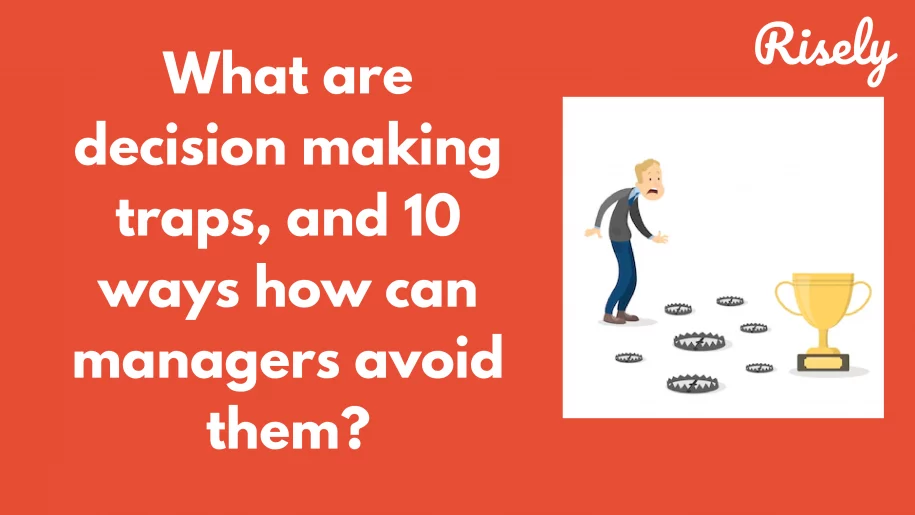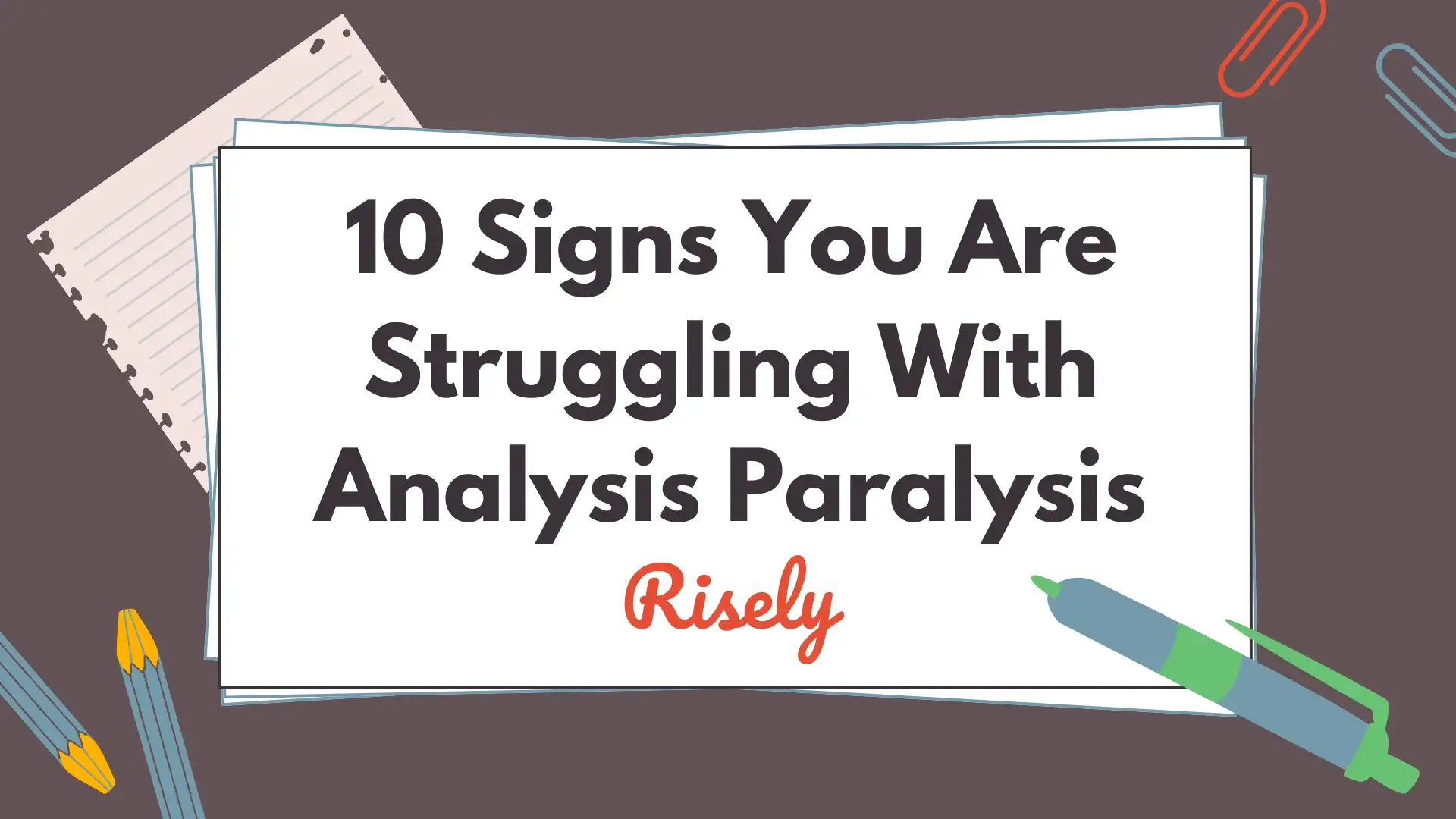What are decision making traps, and 10 ways how can managers avoid them?
Making decisions is an essential part of our daily lives, whether in our personal or professional life. However, navigating the complexities of decision making can be challenging, especially when biases and other traps come into play. These traps, whether they are visible or hidden, can have a significant impact on the quality of our decisions and, ultimately, on our success. This blog will explore the various decision making traps and their impact on our ability to make informed decisions. Understanding these biases and learning how to identify and mitigate them can increase our chances of making effective and impactful decisions.What is decision making?
Decision making is the process of choosing between different alternatives or options to achieve a desired outcome. It involves identifying a problem or opportunity, gathering information and data, evaluating various options, and selecting the best action. Decision making is critical in both personal and professional life, as it determines the direction and outcomes of individual and organizational goals. Effective decision making requires good judgment, critical thinking skills, and a thorough understanding of the situation and available options. It can involve trade-offs, weighing the pros and cons of each option, and balancing short-term and long-term considerations. Decisions can range from simple, routine choices to complex, strategic decisions with far-reaching consequences. Ultimately, the goal of decision making is to make the best choice possible, given the available information and constraints.What are decision making traps?
Decision making traps refer to common biases and tendencies that can negatively impact the decision making process and lead to low productivity. They occur when people allow unconscious biases, past experiences, or emotions to influence their judgment, leading them to make decisions that are not based on sound reasoning and logic. These decision making traps can lead to poor outcomes and result in missed opportunities, reduced efficiency, and decreased success. To avoid decision making traps, it is essential to be aware of them, evaluate information and options critically, and seek out diverse perspectives and opinionsWhat are some visible decision making traps?
Some decision making traps are more noticeable and easier to identify than others. Some common and easily noticeable decision making traps include: 1. Confirmation Bias: This is the tendency to seek out and give more weight to information that supports existing beliefs while disregarding or discounting information that contradicts them. This trap can lead to a narrow and skewed view of the situation, making it easier to spot. 2. Overconfidence: This is when people are overly confident in their ability to make accurate predictions and decisions, leading to a disregard of evidence and potential risks. This trap is often easily noticeable as people act excessively boldly or make irrational decisions. 3. Anchoring Bias: This occurs when people become anchored to a specific value or piece of information and use it as a reference point when making decisions, even if it is not relevant or appropriate. This trap can be easily noticeable as people may make inconsistent or not well-supported decisions. 4. Groupthink: This is the phenomenon where people conform to the opinions and decisions of a group, even if they would have made different decisions individually. This trap can be easily noticeable as it may result in a lack of diversity in opinions and decision making within a group. 5. Emotional Bias: This occurs when emotions such as fear, anxiety, or excitement influence decision making. This trap can be easily noticeable as people may make decisions based on their emotions rather than rationally evaluating the available options. We have for you 5 ways good managers combine decision making and emotional intelligence. By being aware of these easily noticeable decision making traps, individuals and organizations can take steps to minimize their impact and improve their decision making processes.What is some hidden decision making traps?
Hidden decision making traps are biases, tendencies, and errors that can influence decision making in subtle ways, making them difficult to detect and overcome. Some common hidden decision making traps include: 1. Hindsight Bias: This is the tendency to believe, after an event, that the outcome was predictable and that it would have been obvious beforehand. This trap can lead to a false sense of certainty and result in poor future decisions. 2. Escalation of Commitment: This occurs when people persist in the course of action, despite evidence that it is failing due to a sense of commitment to the decision or a desire to justify previous investments. This trap can result in a sunk cost fallacy, where individuals continue to invest in a decision or project even though it may not be rational. 3. Availability Bias: This occurs when people rely on information that is easily accessible or memorable rather than seeking out all relevant information. This trap can lead to poor decision making, as the data used may not be complete or accurate. 4. Framing Effects: This occurs when how information is presented or framed influences how people make decisions. For example, a decision may be viewed as less risky when stated in terms of potential gains rather than losses. 5. The Halo Effect: This occurs when a person’s overall impression of a situation or individual influences their judgment of specific attributes or characteristics. This trap can lead to oversimplified and inaccurate assessments, resulting in poor decisions. These hidden decision making traps can have significant and far-reaching consequences, as they can lead to poor decisions that are not based on sound reasoning and logic. To overcome these traps, individuals and organizations need to be aware of them and take steps to minimize their impact, such as seeking out diverse perspectives, challenging assumptions, and critically evaluating all relevant information. Here are 10 biases in decision making that every manager should know. Follow the link to read about more such biases in details.Other Interesting Reads
Decision making traps examples
Here are some examples of decision making traps in the workplace: 1. Confirmation Bias: A manager may believe that a particular approach to product development is the best and only seek out information that supports this belief, ignoring data or feedback that contradicts it. This could result in the company investing resources in a product that is unlikely to succeed. 2. Anchoring Bias: A manager may use the first budget proposal they receive as a starting point, even if irrelevant, and make subsequent decisions based on that anchor. This could result in a budget not aligning with the company’s culture, needs and goals. 3. Overconfidence Bias: A CEO may believe that their experience and intuition are sufficient to make important strategic decisions without seeking advice from others. This could result in poor decision making and a failure to assess risks accurately. 4. Framing Effect: A manager may present a proposal emphasizing the potential benefits while downplaying the risks. This could lead colleagues to make decisions based on a biased perspective rather than objective facts. 5. Hindsight Bias: A company may believe that it could have predicted a particular market trend based on information that was available at the time. This could lead the company to make the same mistakes in the future by ignoring important information or taking unnecessary risks. 6. Sunk Cost Fallacy: A company may persist with an advertising campaign that is not delivering results due to the resources (time, money, effort) already invested in it. This could result in further financial losses and reduced resources for future investments. These are just a few examples of how decision making traps can occur in the workplace. To avoid these problems, it’s essential for individuals and organizations to be aware of these biases and to take steps to mitigate their impact, such as seeking out diverse perspectives, using decision making frameworks, and conducting regular reviews and audits of decision making processes.How can managers save themselves from falling into decision making traps?
To avoid falling into such traps, managers can take the following steps: 1. Seek Out Diverse Perspectives: Encourage the exchange of different ideas and viewpoints. Encourage team members to challenge their thinking and be open to feedback. 2. Use a Systematic Decision Making Framework: Utilize a structured approach to decision making that helps identify and weigh the relevant factors. This can help ensure that all relevant information is considered and that decisions are based on a comprehensive assessment of the situation. 3. Monitor for Bias: Regularly check for biases in your thinking and decision making processes. Consider seeking out an outside perspective to provide an unbiased assessment of the situation. 4. Conduct Regular Reviews: Regularly review decisions and their outcomes to assess whether they are sound. This can help you identify areas for improvement and avoid making the same mistakes in the future. 5. Stay Informed: Stay up to date with the latest research and best practices in decision making. Attend training programs and workshops to enhance your skills and knowledge. 6. Practice Self-Awareness: Engage in self-reflection to become more aware of your biases and tendencies. Seek out feedback from others and be open to constructive criticism. 7. Consider the Consequences: Take the time to consider the potential consequences of your decisions. Think through the possible scenarios and weigh the risks and benefits of each option. 8. Seek Out Disconfirming Evidence: Challenge your assumptions by seeking out information that contradicts your beliefs. This can help you identify potential biases and ensure that you are considering all relevant information. 9. Collaborate with Others: Work with a team of people with different backgrounds and expertise. By collaborating with others, you can tap into diverse perspectives and reduce the impact of biases in your decision making. 10. Practice Mental Simulation: Visualize the possible outcomes of different decisions. This can help you identify potential risks and benefits and make more informed decisions. Managers can increase their chances of making sound decisions and avoiding common pitfalls by taking these steps. In addition, by being aware of these biases, managers can be more effective in their decision making, leading to better outcomes for themselves and their organizations.Conclusion
In conclusion, decision making traps are common biases that can negatively impact our ability to make sound decisions. These biases can manifest in various forms, from confirmation bias to sunk cost fallacy, and can have far-reaching consequences for individuals and organizations. By being aware of these biases and taking steps to mitigate their impact, such as seeking out diverse perspectives and using a systematic decision making framework, we can increase the chances of making informed and effective decisions. Furthermore, by recognizing the impact of decision making traps and taking action to avoid them, we can improve our decision making processes and achieve better outcomes.Can your decision-making skills help you jump traps?
Start the assessment below to uncover useful insights on your decision-making skills in just a few minutes
Other Related Blogs
10 Signs You’re Struggling with Analysis Paralysis at Work
10 Signs You’re Struggling with Analysis Paralysis at Work The smart fox declares, “I have a hundred ways to escape when trouble approaches. You have only one.” As the dogs…
Evidence Based Decision Making: 4 Proven Hacks For Managers
Evidence Based Decision Making: 4 Proven Hacks For Managers In this blog, we will explore the concept of evidence-based decision-making and provide seven proven hacks for managers to implement evidence-based…
6 Best Books On Decision Making For Managers
6 Best Books On Decision Making For Managers Effective decision-making is crucial for managers to navigate the complexities of their roles. You are responsible for making important choices that can…
Best Decision Coaches To Guide You Toward Great Choices
Best Decision Coaches To Guide You Toward Great Choices Effective decision-making is more crucial than ever in today’s rapidly evolving business landscape. Entrepreneurs, leaders, and professionals alike are constantly faced…


